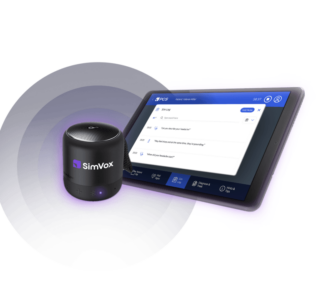Neonatal Lung Simulator LuSi from neosim Creates Realistic Pediatric Ventilator Training
neosim’s LuSi, the Neonatal Lung Simulator, is the world’s first autonomous and advanced baby lung clinical simulator with real-time artificial intelligence. LuSi trains healthcare clinicians and students in the assessment of pulmonary function and the responses of newborns and neonates to treatment without requiring an operator’s intervention. This HealthySimulation.com article will explore the benefits and features of neosim’s LuSi, lung simulator.
LuSi can simulate pathologies like RDS (respiratory distress syndrome), meconium aspiration syndrome, broncho-pulmonary dysplasia, transient apnoea of newborn, lung collapse, weak muscular activity, pneumothorax, airway obstruction, and other lung disorders. LuSi responds to the learner’s treatments and interventions autonomously, without the need for operator input. More than 60 parameters provide pathologic responses based on scientific literature and human pathophysiology to provide a more realistically human response.
Healthcare professionals that care for neonates and newborns must be educated at the highest level in order to provide evidence-based care to improve patient outcomes. This population is at higher risk for complications and negative outcomes which makes learning to manage their care with critical thinking is imperative. The learner uses his/her own actual ventilation devices, both invasive and non-invasive, of any make (except NAVA), any mode including high-frequency ventilation (both jet and oscillatory).
Sponsored Content:
View the HealthySimulation.com LEARN CE/CME Platform Webinar Using Real Mechanical Ventilators with Autonomous neosim Lung Simulators to learn more! Covered in the webinar will be LuSi and the TestChest Lung Simulator:
LuSi, neosim’s Neonatal Lung Simulator, is the world’s first autonomous and advanced baby lung simulator with real-time artificial intelligence. The product is designed to train clinicians in the assessment of pulmonary function and respond to treatment without operator’s intervention. In doing so, the product can simulate pathologies like RDS, lung collapse, weak muscular activity, pneumothorax, airway obstruction, etc.
TestChest is an innovative full physiologic artificial lung that provides a breakthrough in mechanical ventilation training. The product was developed to simulate the human heart and respiratory system for teaching and training purposes. TestChest can be used either as a stand-alone skill training station or integrated into a full-scale patient simulator.
The autonomous responses to treatment can minimize operator error in the responses to the care provided. LuSi will inform the learners what is correct or incorrect based on their actions. Some of the functions that require learner interventions in medical simulation are issues with lung volume, breathing patterns, and ventilation inhomogeneity normally seen in the preterm and term infants.
Sponsored Content:
To enhance realism, LuSi is housed in the realistic manikin. This combination provides a more immersive experience that allows the learners to develop empathy in caring for term infants.
LuSiLIFE
LuSiLIFE is the control software for LuSi that runs on all laptops with a Windows operating system. LuSiLIFE communicates with LuSi via Bluetooth technology. LuSiLIFE is a program to build and execute pathology-based simulations. The software comes with preloaded clinical scenarios but at the same time it allows for making on the fly changes to various scenarios and to design new cases from scratch. Notes can be taken, and complete data recorded, enabling analysis with learners at a later time.
Integrated Vital Signs Monitor
The Vital Signs Monitor window displays real-time treatment results. The display includes pre-ductal and post-ductal arterial pulse oximetry, ECG with heart rate, capnography with EtCO2, SpO2 with plethysmograph. One advantage of the vitals monitor is the flexibility to match the configuration of the institution’s current monitoring devices. Vital signs parameters are calculated based on actual measured values that include pressure, flow, and volume, along with case-specific pathologies like dead space, CO2 production, and lung compliance.
Lusi displays a real time arterial blood gas that changes dynamically in sync with the disease condition. Lusi also displays pressure volume curves in sync with the disease pattern.
LuSi is shipped in a flight case, complete with rechargeable batteries, a battery charger, and software, making it ready to use. It can be utilized in hospital settings or training facilities without the need for CO2 gas or actual monitoring equipment.
More About neosim
neosim is a Swiss company founded by clinical experts with a strong background in lung physiology and mechanical ventilation. neosim was founded on the development principles for healthcare simulators that have autonomous physiology which are based on published scientific data and are as close to reality as possible. The mission of neosim is to save lives from day one by using our autonomous simulators. For training and education of clinicians, especially respiratory therapists and intensive care professionals, neosim simulators create realistic breathing in health and disease. In contrast to other simulators, neosim’s simulators can be treated with intensive care therapy methods and equipment and respond autonomously like a real human patient. The results manifest themselves clinically and can be measured quantitatively with state-of-the-art monitoring in real-time.
neosim sought to create autonomous human lung simulators-real-time artificial intelligence for high-quality respiratory therapy training and education. The goal was to provide clinical training on mechanical ventilation for hospitals, simulation centers, and universities. Thus, the design support and testing of respiratory devices for manufacturers, test-houses, and biomedical engineering all kept in mind quality assurance for hospitals and manufacturers of respiratory care devices.
Ultimately, autonomous human lung simulators allow learners to accurately follow the actions of the ventilator and gain an understanding of the dynamics of closed-loop control as if there was a patient – but without harming a patient. Additionally, autonomous human lung simulators allow clinicians to expose the workings of their intensive care ventilators and respiratory support devices – and to improve the management of patients, according to neosim.
Teresa Gore, PhD, DNP, APRN, FNP-BC, CHSE-A, FSSH, FAAN – Dr. Gore has experience in educating future nurses in the undergraduate and graduate nursing programs. Dr. Gore has a PhD in Adult Education, a DNP as a family nurse practitioner, and a certificate in Simulation Education. Dr. Gore is an innovative, compassionate educator and an expert in the field of healthcare simulation. In 2007l Teresa started her journey in healthcare simulation. She is involved in INACSL and SSH. She is a Past-President of INACSL and is a Certified Healthcare Simulation Educator Advanced (CHSE-A). In 2018, she was inducted as a Fellow in the American Academy of Nursing (FAAN). In 2021, she was inducted as a Fellow in the Society of Simulation in Healthcare Academy (FSSH) and selected as a Visionary Leader University of Alabama at Birmingham School of Nursing Alumni. During her career, Dr. Gore has led in the development and integration of simulation into all undergraduate clinical courses and started an OSCE program for APRN students. Her research interests and scholarly work focus on simulation, online course development and faculty development. She has numerous invited presentations nationally and internationally on simulation topics.
Sponsored Content:




















